7 eCommerce Metrics Online Businesses Must Know to be Successful
This may sound unbelievable, but revenue is not the only important benchmark when tracking eCommerce success. Why? Because revenue generation is just one part of the equation of a profitable and sustainable business. If deployment costs are dramatically lower, a campaign making $100k in revenue could be better than one making $150k. It's all about the cost to acquire that revenue.
There are seven metrics to understand the effectiveness of your eCommerce campaigns:
Average Order Value (AOV)
Let's start with one that is simple. Average Order Value (AOV) is the foundation of tracking averages across the reporting on your eCommerce business. AOV is essential because the more each customer purchases, the better your overall ROI on digital campaigns (think search and social).
Here’s how to calculate AOV:
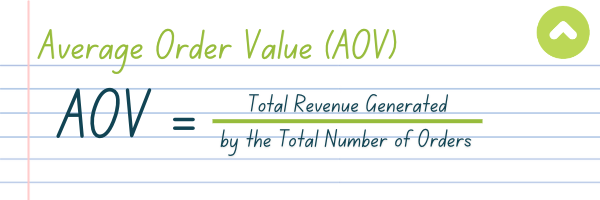
For all these averages, at least 6-12 months of data should be aggregated to get an accurate and steady benchmark.
Customer Lifetime Value (CLV)
Customer Lifetime Value (CLV) is the new gold standard. CLV assigns weights to repeat customers so you can gauge an ROI from recent customer acquisition based on a metric other than last click attributed first-time sales, otherwise known as Return on Ad Spend (ROAS).
The key here is to make the right first impression on a sale so the customer will want to return.
To calculate CLV, multiply the average order value by the average number of purchases per year by the average customer retention rate.
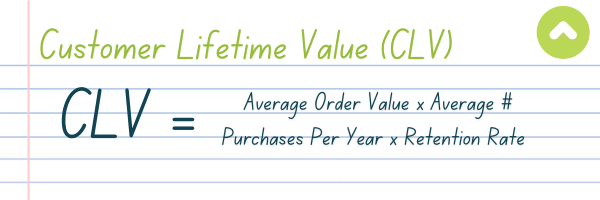
For example, if the AOV = $75 and the average customer purchases 3 times per year for 4 years, the CLV = $900
Customer Acquisition Cost (CAC)
CLV can be combined with the cost of acquiring one new customer, or Customer Acquisition Cost (CAC). This is a benchmark to hold close and track often.
Subtract a new customer's CAC from CLV to see the real value and ROI over time. This equation is a much more accurate and compelling story than Return on Ad Spend (ROAS) for one-time purchases.
Here’s how to calculate CAC:
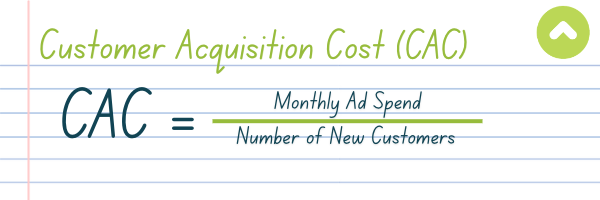
For example, if the monthly ad spend is $12,000 and the new customers acquired in the campaign is 215, then the CAC = $55.81
Want to gain a competitive advantage? Know this metric, benchmark it for your eCommerce or retail store, and track it against new campaigns. You'll know exactly where you stand.
Only 16% of companies have calculated the Average Lifetime Value of their customers. 1
Abandoned Cart Rate (ACR)
You've probably heard of Abandoned Cart Rate (ACR) – how often customers leave an item in their cart without purchasing – but may not be capitalizing on cart recovery and customer recovery as well as you should.
Recent studies show that various industries' average abandoned cart rate is 55-80%. Sending a follow-up email can help you recover at least 30% of sales that might otherwise be lost. 2
Here’s how to calculate ACR:
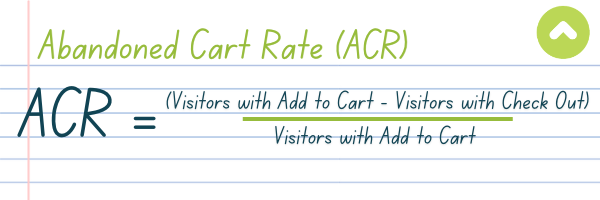
For example, if there are 2000 Add to Carts and 400 Checkouts, the abandoned cart rate is 80%.
There are many reasons why carts are abandoned, but a reminder email is a good starting point for gaining back those customers who left without a purchase. There are also other methods, like improving checkout and adding additional payment options.
There's no single magic formula to reduce WooCommerce abandoned cart rates. What you need to do is focus on improving your store's overall experience and making it easier for customers to purchase products. Here are ten ways you can make that happen.3
Conversion Rate, or Ecommerce Conversion Rate (CVR)
Conversion rate (CVR) is one of the most commonly tracked metrics. Still, it's worth noting that there are a few ways of analyzing CVR and following it along different channels, demographics, times of day, and the like that you can use to help maximize advertising return.
Here’s how to calculate your CVR:
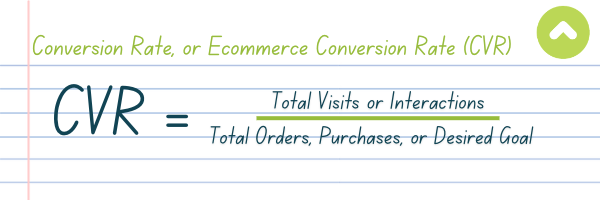
If you find yourself wondering what is a reasonable conversion rate, and how it should be benchmarked and tracked, our friends over at HubSpot have a great article that dials in trending CVR averages and gives a helpful overview of CRO for lead generation and eCommerce.
A "good" conversion rate depends on your industry, niche, goals, traffic channel, and audience demographics, among other factors. For example, the average conversion rate of eCommerce sites globally was 2.17% in the third quarter of 2020, which was down from 2.37% the previous year. The eCommerce conversion rate in the US was higher, however, at 2.57%.
The average not only differs by year and by country — it also differs by niche. For example, the average conversion rate of ecommerce sites in the food and beverage sector is 5.5% whereas the average in the hair care sector is 3.5%.
If your conversion rate is lower than you'd like — maybe it's below average in your industry, or lower than your top competitors, or simply underperforming against your own goals — then it's time to optimize.4
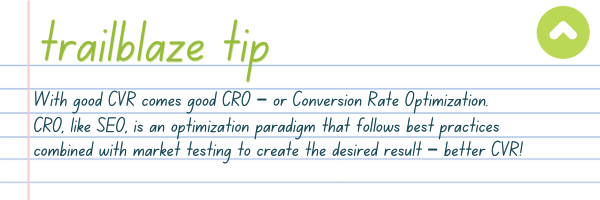
New Customer Acquisition (NCA)
Brands with Ecommerce typically advertise to acquire new customers. The process of acquiring and maintaining new customers is a fundamental business principle at its core. New Customer Acquisition (NCA) is and forever will be the lifeblood of any DTC (Direct to Consumer) brand. Understanding the percentage of new visitors and the rate of those new customers converting over a particular period is essential to realizing ROI on advertising spending.
Again, the folks at HubSpot nailed a helpful overview of exploring and understanding NCA.
Acquisition marketing is the process of creating an advertising and promotion strategy that specifically targets consumers who are already considering your products and services. These consumers are aware of your brand, making them prime candidates for conversion. 5
Average Time to Conversion (T2C)
Although this list has been a mix of must-have metrics, always-on metrics, and metrics you may not have ever heard of, T2C – or Average Time to Conversion – is probably the least understood of all.
From the first ad impression to the order transaction, how long is this journey on average? How is this even tracked? It is difficult to conceptualize and implement accurate reporting because it includes multiple marketing and advertising channels, technologies, and essentially the entire CX – Customer Experience. Where do brand awareness and customer acquisition overlap in the sales funnel or customer journey? These are all questions that need to be analyzed and customized in the eCommerce reporting for your business.
One simple use case is a Google Ad. The ad unit is displayed, clicked, and a customer buys on the first interaction; this means one channel, two technologies, and a linear customer journey. These types of interactions are common, but not always the case.
The customer often sees multiple or takes part in several interactions, leading to a multi-dimension attribution funnel. But understanding across channels what the time to conversion is will help your acquisition strategy and inform your media campaign length and budget.
Making the Most of eCommerce Metrics

All these metrics can get confusing and seemingly impossible to compile unless you have a good grasp on your eCommerce sales data, Google Analytics 4, and the Ad Platforms data. Having a Marketing Automation system with reporting helps too.
These 7 should be the baseline before spending a significant marketing budget on digital ads. You will need to understand what's working and why. Once you know the why – growth is possible, scaling your campaigns and meeting your goals will be much more efficient and achievable.
To learn more, Book a Meeting with Trailblaze today to start optimizing your online presence.


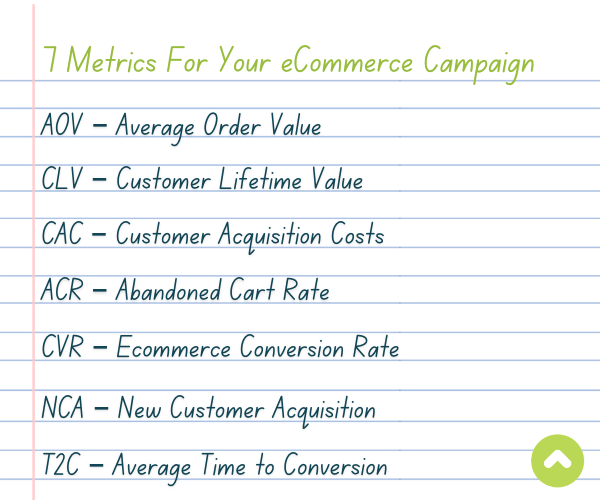

.png?width=630&name=trailblaze%20-%20Blog%20Graphic%20(Text%20Ads).png)



